Uterus Removal Surgery (Hysterectomy): Types & Side Effects
Fertility Treatment
Uterus removal surgery, also known as a hysterectomy, is a surgical procedure that involves the removal of some or all of the uterus. It is the second most common major procedure following cesarean section gynecological surgeries that are performed in women to treat various conditions, such as uterine fibroids, endometriosis, uterine prolapse, abnormal uterine bleeding, chronic pelvic pain, and certain types of cancer (e.g., cervical or uterine cancer).
Different types of hysterectomy surgery include total hysterectomy, subtotal hysterectomy, and radical hysterectomy. While a hysterectomy can relieve certain medical conditions, it is important to be aware of the potential hysterectomy side effects. After a hysterectomy, patients will not menstruate and so get pregnant. Although, they can consider surrogacy as an option to have children.
What Is a Hysterectomy?
A hysterectomy is an operation to remove the uterus. The surgery may also involve removing the cervix, ovaries, and fallopian tubes. The main function of the uterus is to provide a safe environment for the development and growth of a fetus during pregnancy. In addition, a period occurs when the uterus lining (endometrium) is shed during menstruation. Therefore, women cannot get pregnant or get their period after a hysterectomy surgery.

What Are the Different Types of Hysterectomy?
There are several types of hysterectomy, depending on the patient's medical condition and the reason for the procedure. The main kinds of hysterectomy include:
- Total hysterectomy
- Partial hysterectomy
- Radical hysterectomy
- Bilateral hysterectomy

Total hysterectomy
That involves the removal of the entire uterus, including the cervix;
Partial hysterectomy
It is also called subtotal or supracervical hysterectomy): that removes the upper part of the uterus while leaving the cervix intact;
Radical hysterectomy
That is typically performed for certain gynecological cancers and involves the removal of the uterus, cervix, upper part of the vagina, and surrounding tissues, such as lymph nodes;
Total hysterectomy with bilateral salpingo-oophorectomy
That involves the removal of both fallopian tubes and ovaries in addition to removing the uterus.
How Is a Hysterectomy Performed?
There are 3 approaches to perform a hysterectomy:
- Abdominal hysterectomy
- Laparoscopic hysterectomy
- Vaginal hysterectomy
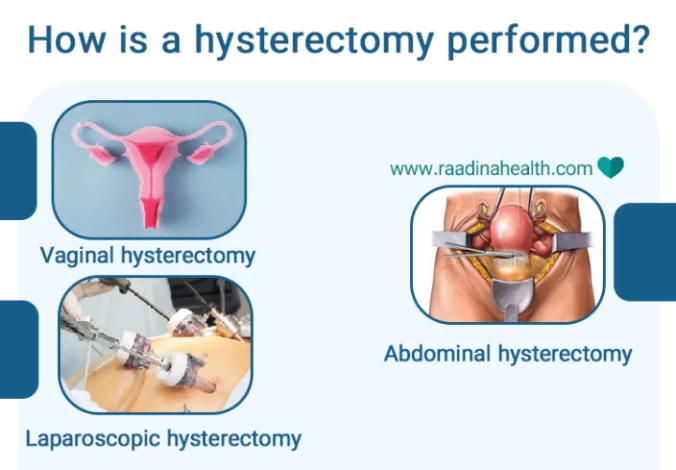
Abdominal hysterectomy
This is the traditional method of performing a hysterectomy that involves making an incision in the abdomen to access and remove the uterus. This approach allows for better visualization and access to the pelvic organs. Although, it requires a longer recovery time and may leave a more prominent scar.
Laparoscopic hysterectomy (keyhole surgery)
Laparoscopic hysterectomy involves making several small incisions in the abdomen through which a laparoscope (a thin, lighted tube with a camera) and surgical instruments are inserted. The surgeon performs the hysterectomy using these instruments while viewing the internal organs on a monitor. This method is a minimally invasive approach that offers benefits such as reduced postoperative pain, shorter hospital stay, and quicker recovery than an abdominal hysterectomy. Laparoscopic hysterectomy can be performed using either traditional laparoscopy or robotic-assisted technology.
Anesthesia | General |
Hospitalization | None or Half-day |
Incision | Yes (10 ml) |
Procedure Time | 1 - 4 hours |
Recovery | 2 - 6 weeks |
Vaginal hysterectomy
In vaginal hysterectomy, the uterus is removed through the vagina without making any external incisions. This approach is less invasive than an abdominal hysterectomy and typically results in a faster recovery and more minor scars. However, Vaginal hysterectomy may not be suitable for all patients, depending on factors such as the uterus size and certain medical conditions.
Anesthesia | General |
Hospitalization | 1 - 2 Days |
Incision | No |
Procedure Time | 1 - 4 hours |
Recovery | 4 - 6 weeks |
What Are the Reasons to Perform a Hysterectomy?
Reasons for a Hysterectomy may include:
- Uterine fibroids or noncancerous growths that develop in the uterus and can cause symptoms such as heavy or prolonged menstrual bleeding, pelvic pain, and pressure on the bladder or rectum;
- Endometriosis in which the tissue that lines the uterus grows outside of it, causing symptoms like pain and female infertility;
- Gynecologic cancers such as uterine, ovarian, or cervical cancer;
- Adenomyosis is a condition in which the uterus lining grows into the muscular wall of the uterus, causing heavy or prolonged menstrual bleeding, pain, and enlargement of the uterus;
- Abnormal or heavy vaginal bleeding that other treatments could not cure;
- Chronic pelvic pain that other treatments could not cure;
- Uterine prolapse if other treatments, such as pelvic floor exercises or a pessary, are not effective;
- Other conditions with the uterus lining, like hyperplasia and recurrent uterine polyps.
How to Prepare for a Hysterectomy?
The patients may schedule a consultation with the surgeon and discuss their reasons for undergoing a hysterectomy before a hysterectomy. The doctor will explain the hysterectomy procedure, including its potential risks and side effects.
The doctor may also order blood tests, ultrasounds, and other diagnostic tests to evaluate the patient's health and identify possible complications.
During the consultation session, the patients will inform the doctor about all the medications they are currently taking, including prescription drugs, over-the-counter medications, and supplements. Some medications may need to be adjusted or temporarily stopped before the surgery.
The doctor will provide specific instructions regarding fasting before the surgery, which medications to take or avoid on the day of surgery, and when to arrive at the hospital or surgical center.
It is recommended that patients quit smoking, as it can interfere with the healing process.

What Occurs During a Hysterectomy?
The uterus is removed during a hysterectomy. The specific steps of the procedure will vary depending on the surgical approach chosen.
During an abdominal hysterectomy
A six- to eight-inch-long incision is made in the abdomen. The surgeon carefully separates the uterus from surrounding tissues and blood vessels and then removes the uterus through the incision. Other reproductive organs, such as the ovaries or fallopian tubes, may be removed if necessary.
During a vaginal hysterectomy
An incision is made at the top of the vagina. Then the surgeon detaches the uterus from its supporting ligaments and blood vessels and removes it through the vaginal incision.
During a laparoscopic or robotic-assisted hysterectomy
Small incisions are made in the abdomen. A laparoscope (a thin tube with a video camera on the end) or robotic instruments are inserted through these incisions to visualize and manipulate the uterus. The surgeon then removes the uterus using specialized instruments.
How Long Does a Hysterectomy Surgery Last?
On average, a hysterectomy can take around 1 to 3 hours. This time can vary depending on the surgical approach chosen, the case's complexity, the uterus's size, and the surgeon's experience.
What Happens After a Hysterectomy?
After removing the uterus, the patient will be monitored closely in the recovery room. The doctor will prescribe pain medications to manage any discomfort patients may experience.
Patients should stay in the hospital for a few days after performing an abdominal hysterectomy. Vaginal and laparoscopic hysterectomies are less invasive and usually do not need an overnight stay in the hospital.

How Is Recovery from a Hysterectomy and How Long Does It Take?
The recovery time after a hysterectomy can vary depending on several factors, including the type of hysterectomy performed, the patient's overall health, and any complications that may arise during or after the procedure.
Recovery time after vaginal and laparoscopic hysterectomies are less than recovering from abdominal hysterectomies.
The initial recovery period may take about 4 to 6 weeks, during which patients are advised to avoid strenuous activities and heavy lifting. However, it is important to note that full recovery and return to normal activities can take several months.
Recovering at Home after a Hysterectomy
Recovering at home after a hysterectomy can be a gradual process. Here are some general postoperative instructions to help patients during hysterectomy recovery time:
- Get plenty of rest, take naps throughout the day, and avoid overexertion to allow the body to heal;
- Take the prescribed pain medication, and use ice packs or heating pads to manage any discomfort and alleviate pain and swellings;
- Follow the doctor's instructions on how to care for the incisions, keep the incision areas clean and dry, and change dressings as directed;
- Take short walks around the house or do light stretching exercises to prevent blood clots and promote healing;
- Eat a balanced diet with plenty of fruit, vegetables, and lean proteins to support healing;
- Stay hydrated by drinking enough water throughout the day;
- Wear supportive undergarments, such as compression garments or abdominal binders, to reduce swelling during the recovery period;
- Avoid lifting heavy objects;
- Attend all scheduled follow-up appointments with the doctor to monitor the healing progress and address concerns.
What Are the Most Common Side Effects of a Hysterectomy?
The most common side effects of a hysterectomy may include:
- Pain and discomfort in the abdominal area or the incision site that can be managed with pain medications prescribed by the doctor;
- Fatigue that is usually temporary and improves over time;
- Vaginal bleeding or discharge that is normal and should gradually decrease over time;
- Changes in bowel and bladder function, such as constipation or urinary urgency that usually resolve within a few weeks;
- Menopausal symptoms such as hot flashes, night sweats, loss of libido, mood swings, and vaginal dryness (if the ovaries are removed during the hysterectomy);
- Emotional and psychological effects.

What Is a Surgical Menopause?
If one or both ovaries are removed during a hysterectomy (called oophorectomy), it can result in a sudden menopause. This can cause symptoms such as hot flashes, mood swings, vaginal dryness, and decreased bone density. Hormone replacement therapy may be recommended to manage these symptoms.
What Are the Advantages of Undergoing a Hysterectomy?
For patients with chronic gynecological conditions or severe symptoms, a hysterectomy can lead to an improved quality of life. Relief from pain, heavy bleeding, and other symptoms can allow patients to engage in activities they previously avoided or enjoy better overall well-being.
Furthermore, hysterectomy is often performed as a uterine or cervical cancer treatment option. Removing the uterus and possibly other affected tissues can help eliminate or reduce the spread of cancer cells. Hysterectomy is also the last option for treating endometriosis for women with heavy menstrual bleeding, fallopian tube cancer, severe inflammation, and pain in the pelvic area.
What Are the Disadvantages of Undergoing a Hysterectomy?
A hysterectomy involves the removal of the uterus, which means that a person will no longer be able to conceive or carry a pregnancy. This can be a significant disadvantage for individuals who still desire children.
Depending on the type of hysterectomy performed, hormonal changes may occur. If the ovaries are also removed (oophorectomy), this can lead to menopause and its associated symptoms, such as hot flashes, mood swings, and decreased libido.
Removing the uterus may have long-term complications on pelvic support and bladder function. Some patients may experience urinary incontinence or pelvic organ prolapse after a hysterectomy.
How Common Is It to Get a Hysterectomy?
According to estimates, about one in ten women will perform hysterectomy in their lifetime. This makes the surgery one of the most common surgical procedures in women. However, the hysterectomy rate has declined in recent years due to advancements in alternative treatments and a shift towards more conservative approaches.
What Are the Complications of a Hysterectomy?
Like any major surgery, a hysterectomy carries some risks. Complications of a hysterectomy may include:
- Infection at the incision site or within the pelvic area after surgery;
- Heavy bleeding during or after the surgery;
- Blood clots;
- Damage to surrounding organs or structures such as the bladder, ureters (tubes that connect the kidneys to the bladder), or intestines;
- Adverse reactions to anesthesia;
- Pelvic support problems leading to pelvic organ prolapse;
- Urinary problems like urinary incontinence or difficulty emptying the bladder;
- Sexual dysfunction, including decreased libido, vaginal dryness, or pain during intercourse;
- Psychological and emotional effects include feelings of loss, grief, or changes in body image.
It is important to note that while these complications are possible, they are relatively rare. The majority of hysterectomies are performed without significant complications. Discussing these potential risks with a healthcare provider before the procedure is crucial.
How Much Is the Cost of a Hysterectomy in Iran?
The cost of a hysterectomy in Iran may vary from $1400 to $2400, depending on factors such as the type of hysterectomy, the hospital or clinic chosen, the surgeon's fees, and any additional medical services required.

When to See a Doctor After a Hysterectomy?
Patients should see a doctor if they experience any of the following symptoms after a hysterectomy:
- Heavy vaginal bleeding;
- Severe or worsening pain that cannot be relieved by medication as it could be a sign of infection or other complications;
- Fever above 100.4°F (38°C) that may indicate an infection;
- Difficulty breathing or chest pain could be a sign of a blood clot in the lungs;
- Difficulty urinating or frequent urination.
The Final Word
Hysterectomy is a major surgical procedure that can significantly affect women's lives. Therefore, it is crucial to carefully consider the potential benefits and risks before deciding and seeking appropriate medical advice.
Feel free to contact our experts at Raadina Health for assistance regarding hysterectomy in Iran.
We can provide information on the average cost of a hysterectomy in Iran and help you find reputable hospitals or clinics that offer this procedure. Additionally, we can assist with arranging appointments, obtaining medical visas, and organizing travel and accommodation arrangements.
Frequently Asked Questions About Hysterectomy
1) Will I experience menopause after a hysterectomy?
Entering menopause after a hysterectomy depends on whether or not the ovaries are removed during the procedure. If the ovaries are left intact, they will continue to produce hormones, and menopause will not occur immediately. However, if the ovaries are removed (oophorectomy), it can lead to surgical menopause,
2) Do I still need a Pap test if I have had a hysterectomy?
If the hysterectomy was performed for non-cancerous reasons and the cervix was left intact, regular Pap tests may still be advised to screen for cervical cancer.
3) Will I need to stay in the hospital after having a hysterectomy?
Yes, a hospital stay of a few days may be required for observation and post-operative care.. The length of hospital stay after a hysterectomy can vary depending on several factors, including the type of hysterectomy performed and individual recovery.
4) Will I experience any changes in my sexual life after a hysterectomy?
Some women may experience changes in sexual function or libido after a hysterectomy, but this can vary from person to person.
5) Can a hysterectomy result in chronic pain?
Yes, a hysterectomy can sometimes result in chronic pain. While a hysterectomy is generally a safe and effective procedure, there are potential risks and complications associated with it, including the development of chronic pain. Some possible causes of chronic pain after a hysterectomy include nerve damage, scar tissue formation, pelvic floor dysfunction, and surgical site infections




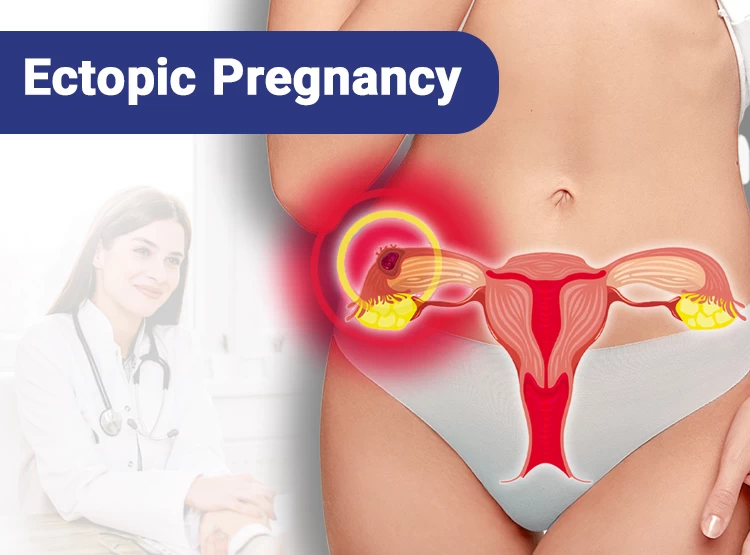

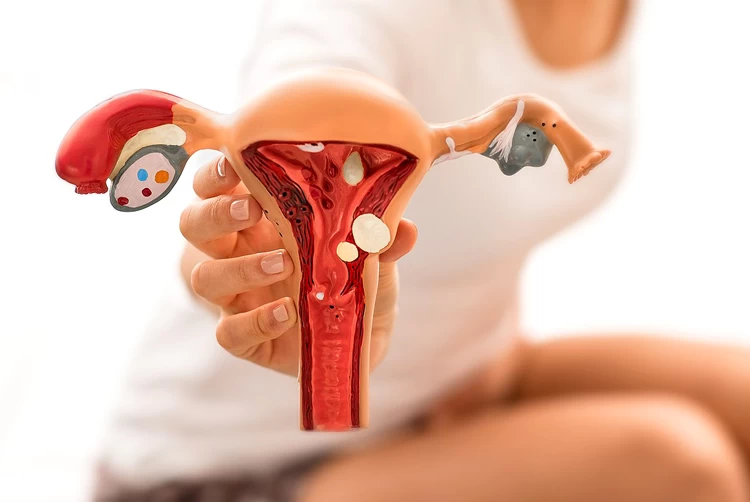

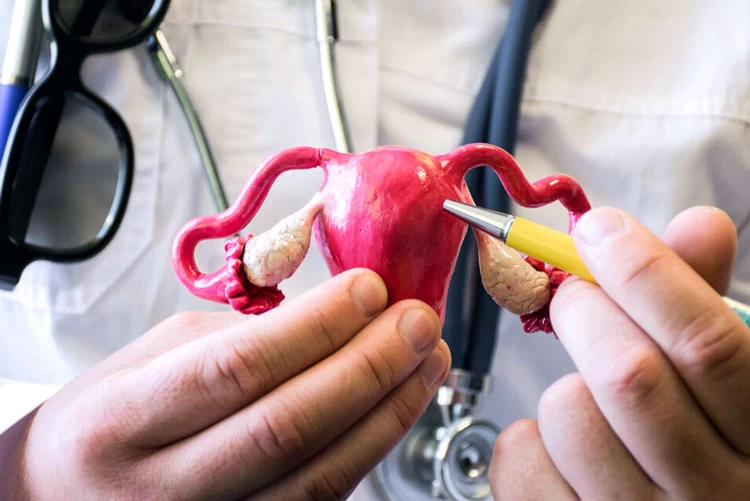


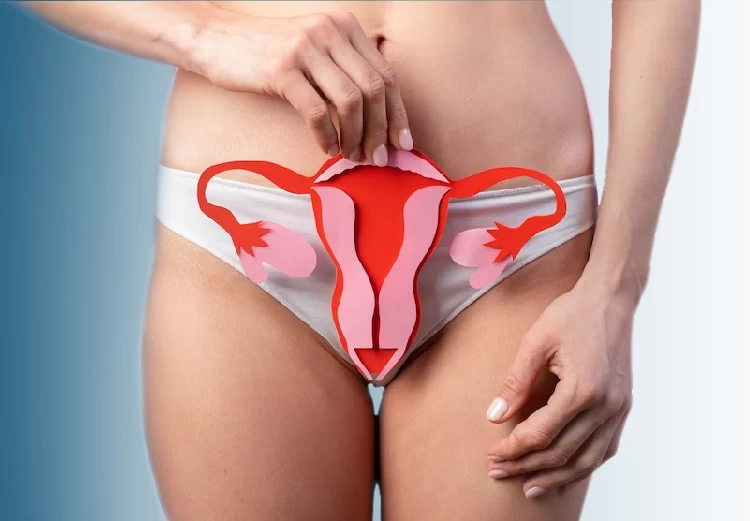
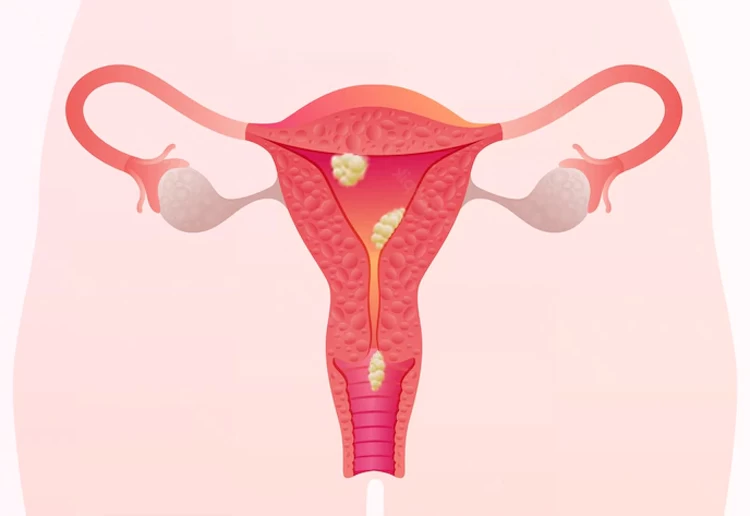


No reviews
Your comment